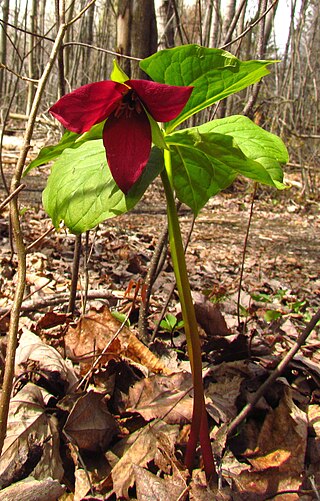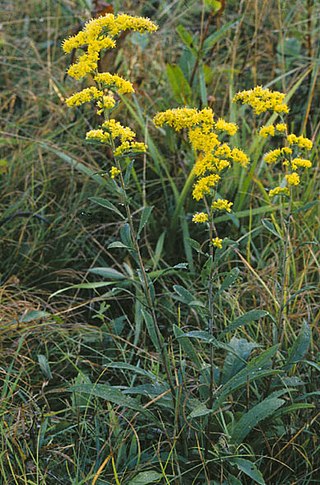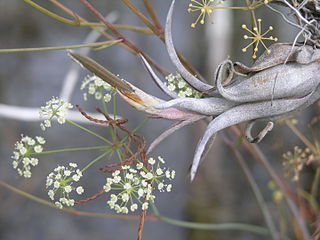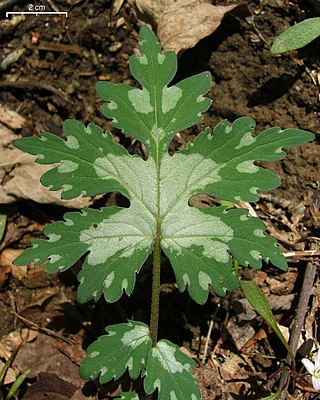
Trillium is a genus of about fifty flowering plant species in the family Melanthiaceae. Trillium species are native to temperate regions of North America and Asia, with the greatest diversity of species found in the southern Appalachian Mountains in the southeastern United States.

Trillium erectum, the red trillium, also known as wake robin, purple trillium, bethroot, or stinking benjamin, is a species of flowering plant in the family Melanthiaceae. The plant takes its common name "wake robin" by analogy with the European robin, which has a red breast heralding spring. Likewise Trillium erectum is a spring ephemeral plant whose life-cycle is synchronized with that of the forests in which it lives. It is native to the eastern United States and eastern Canada from northern Georgia to Quebec and New Brunswick.

Goldenrod is a common name for many species of flowering plants in the sunflower family, Asteraceae, commonly in reference to the genus Solidago.

Oenanthe, known as water dropworts, oenanthes, water parsleys, and water celeries, are a genus of plants in the family Apiaceae. Most of the species grow in damp ground, such as in marshes or in water.

Retama is a genus of flowering bushes in the legume family, Fabaceae. It belongs to the broom tribe, Genisteae. Retama broom bushes are found natively in North Africa, the Levant and some parts of southern Europe. Retama raetam and Retama monosperma have white flowers, while Retama sphaerocarpa has yellow flowers. It remains an open question in taxonomy whether the members of the genus Retama should be incorporated into the genus Genista.

Hepatica is a genus of herbaceous perennials in the buttercup family, native to central and northern Europe, Asia and eastern North America. Some botanists include Hepatica within a wider interpretation of Anemone.

Clintonia is a genus of flowering plants in the lily family Liliaceae. Plants of the genus are distributed across the temperate regions of North America and eastern Asia, in the mesic understory of deciduous or coniferous forests. The genus, first described by Constantine Samuel Rafinesque in 1818, was named for DeWitt Clinton (1769–1828), a naturalist and politician from the U.S. state of New York. For this reason, plants of the genus are commonly known as Clinton's lily. The common name bluebead refer to the distinctive fruit of members of the genus. Since fruit color varies somewhat across species, the common name bead lily is used as well.

Harperella is a monotypic genus of flowering plants in the family Apiaceae. Its only species is Harperella nodosa, known as piedmont mock bishopweed and harperella. It is native to riparian environments in the Southeastern United States, found at sites in West Virginia, Maryland, several Southeastern states such as Alabama and North Carolina, and the Ouachita National Forest in Arkansas and Oklahoma. As Ptilimnium nodosum, it was placed on the United States' Endangered Species List in 1988.

Ptilimnium is a group of plants in the family Apiaceae described as a genus in 1819. The common name is mock bishopweed or mock bishop's weed. It is endemic to the United States, primarily in the Southeast, the Lower Mississippi Valley, and the Lower Great Plains.

Myrica is a genus of about 35–50 species of small trees and shrubs in the family Myricaceae, order Fagales. The genus has a wide distribution, including Africa, Asia, Europe, North America and South America, and missing only from Australia. Some botanists split the genus into two genera on the basis of the catkin and fruit structure, restricting Myrica to a few species, and treating the others in Morella.

Potentilla indica known commonly as mock strawberry, Indian-strawberry, or false strawberry, often referred to as a backyard strawberry, mainly in North America, is a flowering plant in the family Rosaceae. It has foliage and an aggregate accessory fruit similar to that of a true strawberry. It has yellow flowers, unlike the white or slightly pink flowers of true strawberries. It is native to eastern and southern Asia, but has been introduced to many other areas as a medicinal and an ornamental plant, subsequently naturalizing in many regions worldwide.

Tiarella, the foamflowers, is a genus of flowering plants in the family Saxifragaceae. The generic name Tiarella means "little turban", which suggests the shape of the seed capsules. Worldwide there are seven species, one each in eastern Asia and western North America, plus five species in eastern North America. As of October 2022, the taxonomy of Tiarella in eastern North America is in flux.

Orbexilum, commonly called leather-root, is a genus of flowering plants in the legume family (Fabaceae). They are native to North America, where they are found in the United States and Mexico, south to Chiapas.

Tiedemannia canbyi is a rare species of flowering plant in the carrot family known as Canby's dropwort and Canby's cowbane. It is native to the southeastern United States, where it occurs on the Atlantic coastal plain from North Carolina to Georgia, as well as the Chesapeake Bay area. It is threatened by the loss of the wetland habitat in which it grows. It is a federally listed endangered species of the United States.

Oxypolis rigidior, known as cowbane, common water dropwort, stiff cowbane, or pig-potato, is a species of flowering plant in the carrot family native to eastern North America. It is a perennial wildflower found in wet habitats. Oxypolis rigidior is poisonous to mammals.

Tiedemannia filiformis is a species of flowering plant in the carrot family known by the common names water cowbane and water dropwort. It grows in swamps, freshwater wetlands, and along the borders of ponds in the southeastern United States, as far north as Delaware, as well as the northern Bahamian pineyards of the Bahamas.

Aureolaria levigata, commonly known as entireleaf yellow false foxglove or Appalachian oak-leech, is a species of flowering plant in the family Orobanchaceae. It is native to much of the Appalachian Mountains and surrounding areas in the eastern United States. It is also found in a disjunct population in southwestern Mississippi.

Hydrophyllum canadense, known as bluntleaf waterleaf, broadleaf waterleaf, or Canada waterleaf, is a flowering plant in the borage family, Boraginaceae. It is native to the eastern United States and Canada.

Tiedemannia is a small genus of flowering plants in the carrot family known as cowbanes and dropworts. Species in this genus have been formerly classified in the genera Conium, Oenanthe, and Oxypolis.


















